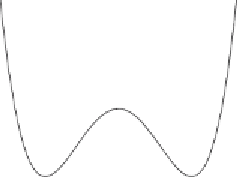Environmental Engineering Reference
In-Depth Information
V
φ
0.4
0.2
2
φ
2
1
1
0.2
Figure 3.17. Typical shape of a bistable potential. In particular, the figure refers to
V
4
2
=
φ
/
4
−
φ
/
2; the minima are at
φ
m
,
1
=−
1 and
φ
m
,
2
=
1, and the height of the
potential barrier, situated at
φ
b
=
0, is
V
=
1
/
4.
Figure
3.17
shows an example of bistable potential, with the two minima,
φ
m
,
1
and
φ
m
,
2
, separated by a potential barrier of height
V
, situated at
φ
=
φ
b
. In this case the
4
2
potential is
V
(
φ
)
=
φ
/
4
−
φ
/
2. In the absence of stochastic and periodic forcings,
the dynamics of the variable
φ
are described by
d
d
t
=−
d
V
d
2
)
=
φ
(1
−
φ
.
(3.57)
φ
Depending on the initial condition, the system will tend to either one of the two
stable states (see Fig.
3.18
) associated with the minima
φ
m
of the potential (i.e.,
φ
m
,
1
=−
1 in this example). The dynamics within each potential well
are characterized by the time scale typical of the process close to the minimum; this
time scale is proportional to
1and
φ
m
,
2
=
d
2
V
d
−
1
φ
=
φ
m
=
t
iw
(3.58)
φ
2
and can be assumed as the intrawell relaxation time. In example (
3.57
)wefind
t
iw
=
1
/
2.
2
φ
t
1.5
1
0.5
t
0.5
1
1.5
2
2.5
3
0.5
1
1.5
2
Figure 3.18. Examples of time trajectory for nonforced dynamics regulated by
Eq. (
3.57
). The different curves correspond to different initial conditions.


































Search WWH ::

Custom Search